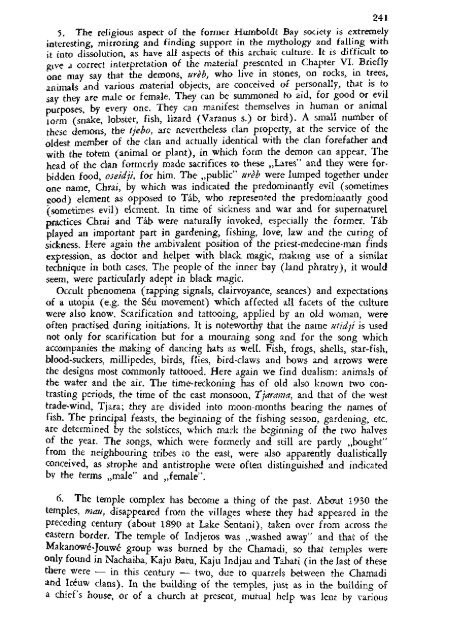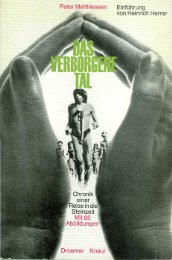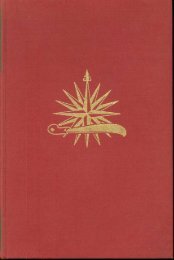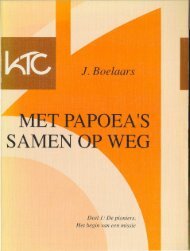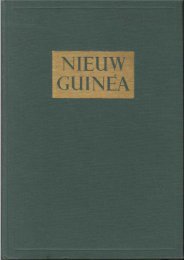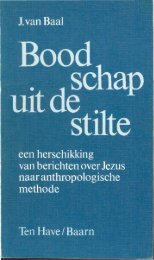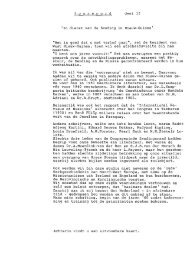Untitled - Stichting Papua Erfgoed
Untitled - Stichting Papua Erfgoed
Untitled - Stichting Papua Erfgoed
Create successful ePaper yourself
Turn your PDF publications into a flip-book with our unique Google optimized e-Paper software.
241<br />
5. The religious aspect of the former Humboldt Bay society is extremely<br />
interesting, mirroring and finding support in the mythology and falling with<br />
it into dissolution, as have all aspects of this archaic culture. It is difficult to<br />
give a correct interpretation of the material presented in Chapter VI. Briefly<br />
one may say that the demons, urèb, who live in stones, on rocks, in trees,<br />
animals and various material objects, are conceived of personally, that is to<br />
say they are male or female. They can be summoned to aid, for good or evil<br />
purposes, by every one. They can manifest themselves in human or animal<br />
form (snake, lobster, fish, lizard (Varanus s.) or bird). A small number of<br />
these demons, the tjebo, are nevertheless clan property, at the service of the<br />
oldest member of the clan and actually identical with the clan forefather and<br />
with the totem (animal or plant), in which form the demon can appear. The<br />
head of the clan formerly made sacrifices to these „Lares" and they were forbidden<br />
food, oseidji, for him. The „public" urèb were lumped together under<br />
one name, Chrai, by which was indicated the predominantly evil (sometimes<br />
good) element as opposed to Tab, who represented the predominantly good<br />
(sometimes evil) element. In time of sickness and war and for supernaturel<br />
practices Chrai and Táb were naturally invoked, especially the former. Tab<br />
played an important part in gardening, fishing, love, law and the curing of<br />
sickness. Here again the ambivalent position of the priest-medecine-man finds<br />
expression, as doctor and helper with black magic, making use of a similar<br />
technique in both cases. The people of the inner bay (land phratry), it would<br />
seem, were particularly adept in black magic.<br />
Occult phenomena (rapping signals, clairvoyance, seances) and expectations<br />
of a utopia (e.g. the Séu movement) which affected all facets of the culture<br />
were also know. Scarification and tattooing, applied by an old woman, were<br />
often practised during initiations. It is noteworthy that the name utidji is used<br />
not only for scarification but for a mourning song and for the song which<br />
accompanies the making of dancing hats as well. Fish, frogs, shells, star-fish,<br />
blood-suckers, millipedes, birds, flies, bird-claws and bows and arrows were<br />
the designs most commonly tattooed. Here again we find dualism: animals of<br />
the water and the air. The time-reckoning has of old also known two contrasting<br />
periods, the time of the east monsoon, Tjarama, and that of the west<br />
trade-wind, Tjara; they are divided into moon-months bearing the names of<br />
fish. The principal feasts, the beginning of the fishing season, gardening, etc.<br />
are determined by the solstices, which mark the beginning of the two halves<br />
of the year. The songs, which were formerly and still are partly „bought"<br />
from the neighbouring tribes to the east, were also apparently dualistically<br />
conceived, as strophe and antistrophe were often distinguished and indicated<br />
by the terms „male" and „female".<br />
6. The temple complex has become a thing of the past. About 1930 the<br />
temples, mau, disappeared from the villages where they had appeared in the<br />
preceding century (about 1890 at Lake Sentani), taken over from across the<br />
eastern border. The temple of Indjeros was „washed away" and that of the<br />
Makanowé-Jouwé group was burned by the Chamadi, so that temples were<br />
only found in Nachaiba, Kaju Batu, Kaju Indjau and Tabati (in the last of these<br />
there were — in this century — two, due to quarrels between the Chamadi<br />
and Iréuw clans). In the building of the temples, just as in the building of<br />
a chief's house, or of a church at present, mutual help was lent by various


